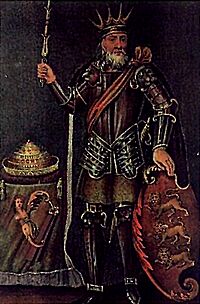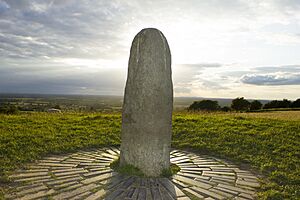High King of Ireland facts for kids
Quick facts for kids High King of Ireland |
|
|---|---|

Anachronistic depiction of High King Brian Boru
|
|
| Details | |
| Style | Ardrí na hÉireann Rí Érenn Uile Imperator Scottorum |
| First monarch | Sláine mac Dela (mythical) Máel Sechnaill I (historical) |
| Last monarch | Ruaidrí Ua Conchobair |
| Formation | 9th century AD |
| Abolition | 12th century AD |
| Residence | Hill of Tara |

The High King of Ireland (Irish: Ardrí na hÉireann) was a special royal title in Gaelic Ireland. It was held by rulers who had, or were said to have had, power over all of Ireland. This title was used for real kings from history. Sometimes, it was also given to legendary figures or used for kings from much earlier times.
Ancient Irish stories often show a long, unbroken line of High Kings. These kings supposedly ruled from the Hill of Tara over many smaller kingdoms for thousands of years. However, modern historians think this idea was mostly created around the 8th century. It helped powerful families justify their rule by making it seem like their family had always been important. Before the 9th century, it's unlikely any king truly controlled the whole island.
The idea of a single king ruling all of Ireland first appeared in the 7th century. But it only started to become a real political goal during the Viking Age. Even then, the High King never ruled Ireland as one single country. Instead, the High King was seen as a powerful overlord. This means he had authority over, and received payments from, the many independent kingdoms below him.
Contents
Early Kings and Their Sacred Role
Early Irish kings were thought to have a special, almost magical, connection to their land. Some old stories say that High Kings gained their power by "marrying" a sovereignty goddess. This meant they were chosen by the land itself. A High King was expected to be perfect and without flaws. He had to follow certain symbolic rules (called buada) and avoid certain forbidden actions (called geasa or taboos).
How Kingship Was Organized
According to old Irish laws from the 7th and 8th centuries, there was a clear ranking of kings:
- The rí tuaithe was the king of a single small kingdom.
- The ruiri was a king who ruled over several small kingdoms.
- The rí ruirech was a powerful king who ruled over a whole province.
Each king only ruled directly within his own small kingdom. He was responsible for making sure his people were well-governed. This included holding public meetings, collecting taxes, building public works, and handling relationships with other kingdoms. He also had to make sure laws were followed and justice was served.
The land in a small kingdom was owned by different family groups of free people. The king was at the top of a system where people owed loyalty and service to those above them. The king himself came from the most important family group within his kingdom.
Christianity and Old Traditions
Even after Christianity arrived in Ireland, some old ideas about kingship continued. For example, Diarmait mac Cerbaill, a king in the mid-6th century, might have been the last king to "marry" the land in the old way. Stories say he died a special "Threefold death" that was meant for sacred kings. This shows how old beliefs mixed with new ones.
Another example of old traditions mixing with Christianity involves Congal Cáech, a king who was supposedly blinded in one eye. This injury was said to make him imperfect, meaning he could not remain High King. This story suggests that even in Christian times, people still believed a king had to be physically perfect to rule.
How High Kings Were Chosen
The way Irish kings were chosen was quite complex, especially before the Norman takeover in 1171. Ireland had many different kingdoms, and sometimes one king would owe loyalty to another. The rules for who became king were not always clear and often changed.
Sometimes, a king's son would take over. But often, other branches of the royal family would get a turn. It's hard to know if this happened peacefully or through fighting. Old records about kings often don't explain how or why a certain person became king.
Also, family trees were sometimes changed much later. This was done to make an ancestor seem more important or to connect them to a more powerful family. These unclear practices in local kingship also make it hard to understand how High Kings were chosen.
The High King's Real Power
The High King of Ireland was mostly a ceremonial leader. He was like a very important boss, but he only had real power in his own kingdom. For example, High Kings from the southern branch of the Uí Néill family ruled the Kingdom of Meath. High Kings from the northern branch ruled various kingdoms in what is now Ulster.
In 1002, the title of High King was taken from Mael Sechnaill II by Brian "Boruma" mac Cennédig from the Kingdom of Munster. Some historians called this a "takeover" of the throne. But others pointed out that no one had a strict legal right to the kingship. Brian was seen as having as much right as anyone else, and he showed great skill as a leader.
Brian Boru was killed in the Battle of Clontarf in 1014. Mael Sechnaill II became High King again but died in 1022. After 1022 and up until the Norman takeover in 1171, the High Kingship was often held by "Kings with Opposition." This means there were often other powerful kings who challenged the High King's authority.
Later High Kings and Their Kingdoms
By the 12th century, kingdoms were becoming larger and kings were gaining more control. Provincial kings started to live in cities instead of traditional royal sites. They hired officials, received advice from noble counselors, and even had standing armies.
Early royal succession often involved different branches of the wider family taking turns. But later, succession became more limited. It was usually passed down from father to son, brother to brother, or uncle to nephew within a small, powerful royal family that shared a last name.
These powerful families, like the Uí Briain in Munster, the Meic Lochlainn in the North, and the Uí Conchubhair in Connacht, often married each other and competed for power across Ireland. By the time the Anglo-Normans arrived in 1169, these large provincial kingdoms were divided. They became smaller areas controlled by, or rebelling against, one of these powerful families who acted as the King of Ireland.
See also
- History of Ireland
- List of High Kings of Ireland
- List of Irish kingdoms
- Lists of Irish kings

